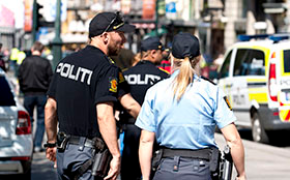Fewer adults and more children among offenders
Published:
The police and prosecution authority completed the investigation of 288 100 offences in 2019. Among these, 141 100 were considered solved. This led to 143 400 charges against 69 350 different offenders, of which 2 928 were children under 15 years of age.
- Full set of figures
- Offences investigated
- Series archive
- Offences investigated (archive)
Over both shorter and longer periods of time, considerable prosecutorial changes are seen in the police and prosecution authority. Most notably so are changes in who are caught for which types of offences, according to new figures from the statistics on offences investigated.
The number of solved and unsolved offences in 2019 is about level with the year before, albeit on the back of a 25 per cent decline over the preceding ten-year period – as shown in figure 1.
Figure 1. Offences investigated, by police decision. Absolute figures
| Prosecution dropped insufficient information about the offender | Prosecution dropped deficient evidence | Prosecution dropped deficient capasity and other unsolved | Prosecution dropped, the offender not liable | Transferred to Conflict Council | Ticket fine | Committed for trial | Prosecution dropped and other solved | |
| 1998 | 195778 | 42280 | 5082 | 7680 | 2251 | 51605 | 73177 | 24242 |
| 1999 | 193843 | 44545 | 4372 | 8531 | 2109 | 56543 | 84165 | 24901 |
| 2000 | 199808 | 44253 | 4889 | 9024 | 2227 | 60830 | 78764 | 25531 |
| 2001 | 183762 | 44066 | 4214 | 9004 | 2272 | 69774 | 87466 | 25495 |
| 2002 | 182894 | 38280 | 7251 | 7894 | 1614 | 62054 | 77989 | 24068 |
| 2003 | 181182 | 40776 | 7998 | 7539 | 1883 | 64161 | 85101 | 26272 |
| 2004 | 169435 | 42718 | 6175 | 8718 | 2170 | 69839 | 86359 | 27792 |
| 2005 | 158296 | 40448 | 4602 | 9290 | 2624 | 70005 | 88962 | 24847 |
| 2006 | 153336 | 37385 | 4560 | 7974 | 2578 | 71971 | 82842 | 21797 |
| 2007 | 152919 | 37238 | 6663 | 9664 | 2620 | 75811 | 79794 | 21642 |
| 2008 | 147174 | 38562 | 6745 | 14116 | 2803 | 71941 | 79178 | 21883 |
| 2009 | 155804 | 37661 | 8436 | 8172 | 2737 | 68675 | 71082 | 21824 |
| 2010 | 142257 | 40081 | 9282 | 7838 | 2550 | 70783 | 74144 | 22967 |
| 2011 | 137436 | 39345 | 10185 | 7587 | 2426 | 68568 | 74957 | 22685 |
| 2012 | 139540 | 37706 | 12141 | 6600 | 2319 | 66960 | 69944 | 24593 |
| 2013 | 133482 | 38835 | 12774 | 6470 | 2381 | 69226 | 68598 | 25373 |
| 2014 | 120640 | 40997 | 13304 | 7148 | 2129 | 66691 | 70015 | 28401 |
| 2015 | 108735 | 40104 | 11237 | 7007 | 2079 | 66274 | 67131 | 26597 |
| 2016 | 100805 | 42141 | 10282 | 7305 | 2194 | 65032 | 68632 | 23012 |
| 2017 | 90282 | 41200 | 11241 | 7639 | 2147 | 56684 | 58691 | 20953 |
| 2018 | 91797 | 42562 | 12259 | 8103 | 1812 | 53039 | 57104 | 20971 |
| 2019 | 90575 | 42088 | 14358 | 8634 | 1747 | 50091 | 57955 | 22676 |
More offences of violence
In 2019, the police completed the investigation of 33 800 offences of violence, which is 4 per cent more than the year before and nearly 10 per cent more than in 2017. About half of all offences of violence settled by the legal system over the previous three years were considered solved.
Furthermore, an increasing number of reported offences are dropped due to deficient investigation capacity, in the new police districts (see text box). This is most common for theft and other types of offences for profit, like fraud. However, also reported violence, threats and other reckless behaviour are dismissed for the same reason.
Smaller share of maltreatment and rape committed for trial
The number of completed investigations of maltreatment in close relations is somewhat level over the last four years. However, a simultaneous decrease is seen in such cases committed for trial or in other ways being settled as solved. In 2019, among the 2 742 completed investigations of maltreatment in close relations, 20 per cent were considered solved. 15 per cent were committed for trial and settled by the courts. In comparison, the clear-up rate and committed for trail rate for maltreatment in close relations were 27 and 22 per cent respectively in 2016.
In recent years, far more sexual offences have been reported and investigated than before. This has led to an increase in the number of charges and charged persons for different types of sexual offences, including rape. From the statistics on the criminal justice process, we know that the processing time may be substantial for cases ending up in court, and especially so for maltreatment in close relations and many types of sexual offences. With big increases in reported offences over short periods of time, the consequential effects on case processing time causes bigger variations in clear-up rates and committed for trail rates than usual. This may be the reason as to why the committed for trail rate for rape (§ 291 and § 294) is as low as 13 per cent over the past two years – and significantly lower than in previous years.
More children caught for offences, especially for petty theft and violence
In 2019, prosecution was dropped for more than 8 600 offences due to the offender not being legally liable. This is a 33 per cent increase from 2013, and can be explained by an increase in the number of children caught for offences in recent years.
Reported offences with offenders under the age of 15 are settled as solved, without the issuing of a penal sanction. In 2019, such offences led to over 4 400 charges against 2 928 children aged 5-14 years. This is a 13 per cent increase from the year before, and an increase of 66 and 52 per cent in charges and charged persons under 15 years respectively since 2015. To find a year with more children charged with offences we have to go as far back as 2010.
In 2019, a little more than 1 100 different children under 15 years accounted for 1 500 charges for property theft, of which the majority were for shoplifting. The number of children charged with theft was 10 and 32 per cent more than in 2018 and 2013 respectively.
A total of 867 children aged 5-14 years, mostly 13 and 14 year olds, were given 1 200 charges for violence and maltreatment. Among these 696 were for physical violence, 267 for threats and 124 for robbery and extortion. Thus, from the principal offence, 2019 saw more than twice as many charges and charged persons under 15 years old than 2015.
Different age profile for persons charged with violence
In recent years, also the age group 15-17 years has seen an increase in charges and charged persons, especially in the group of offence violence and maltreatment. In total, 950 different persons aged 15-17 years were given 1 600 charges for violence and maltreatment in 2019. This is 39 and 54 per cent more than in 2016 respectively.
However, the long term trend for older age groups with fewer charges and charged persons is evident both for all offences and violence and maltreatment. In few years, this has caused big changes in the overall age profile for persons charged with violence and maltreatment – as shown in figure 2.
Figure 2. Persons charged with violence and maltreatment as principal offence, by age. Selected years
| 2005 | 2010 | 2015 | 2019 | |
| 5 | 0.00 | 0.00 | 0.00 | 0.00 |
| 6 | 0.02 | 0.00 | 0.02 | 0.00 |
| 7 | 0.00 | 0.02 | 0.11 | 0.00 |
| 8 | 0.03 | 0.10 | 0.05 | 0.00 |
| 9 | 0.05 | 0.08 | 0.03 | 0.08 |
| 10 | 0.19 | 0.35 | 0.10 | 0.30 |
| 11 | 0.27 | 0.61 | 0.44 | 0.49 |
| 12 | 0.73 | 0.95 | 0.63 | 1.56 |
| 13 | 1.77 | 2.63 | 1.79 | 3.37 |
| 14 | 4.33 | 5.44 | 2.65 | 6.31 |
| 15 | 4.78 | 4.59 | 3.19 | 4.23 |
| 16 | 6.38 | 4.90 | 2.90 | 4.14 |
| 17 | 6.80 | 5.68 | 3.37 | 4.32 |
| 18 | 8.32 | 6.40 | 5.13 | 4.67 |
| 19 | 8.26 | 6.72 | 4.77 | 4.24 |
| 20 | 7.59 | 5.95 | 4.85 | 3.83 |
| 21 | 7.21 | 5.20 | 4.30 | 3.99 |
| 22 | 6.00 | 5.02 | 4.44 | 3.80 |
| 23 | 5.86 | 5.06 | 4.50 | 3.45 |
| 24 | 4.52 | 3.65 | 3.59 | 3.35 |
| 25 | 4.03 | 4.33 | 3.48 | 3.43 |
| 26 | 4.13 | 3.53 | 3.23 | 3.36 |
| 27 | 3.49 | 3.55 | 3.26 | 2.70 |
| 28 | 3.37 | 3.06 | 2.98 | 2.93 |
| 29 | 3.41 | 2.79 | 2.83 | 2.69 |
| 30 | 3.04 | 2.93 | 3.32 | 2.40 |
| 31 | 2.98 | 2.63 | 2.74 | 2.52 |
| 32 | 2.64 | 2.59 | 2.63 | 2.67 |
| 33 | 2.69 | 2.37 | 2.25 | 2.26 |
| 34 | 2.57 | 2.59 | 2.52 | 2.08 |
| 35 | 2.75 | 2.61 | 2.01 | 2.19 |
| 36 | 2.64 | 2.39 | 2.30 | 2.28 |
| 37 | 2.61 | 2.10 | 2.34 | 2.28 |
| 38 | 1.87 | 1.62 | 2.25 | 2.21 |
| 39 | 2.09 | 2.36 | 1.91 | 1.88 |
| 40 | 2.26 | 2.08 | 2.25 | 1.93 |
| 41 | 2.01 | 1.90 | 2.10 | 1.97 |
| 42 | 2.07 | 1.82 | 1.84 | 1.48 |
| 43 | 2.22 | 1.88 | 1.94 | 1.93 |
| 44 | 1.91 | 1.54 | 1.78 | 1.86 |
| 45 | 1.81 | 1.57 | 1.79 | 1.52 |
| 46 | 1.40 | 1.43 | 1.78 | 1.73 |
| 47 | 1.32 | 1.43 | 1.59 | 1.71 |
| 48 | 1.22 | 1.46 | 1.61 | 1.43 |
| 49 | 1.26 | 1.50 | 1.22 | 1.54 |
Fewer charged with narcotic offences
The reduction in reported and prosecuted narcotic offences in recent years contributes to the overall decrease in charged persons among older juveniles and adults. Of the 24 000 solved narcotic offences in 2019, 8 000 were settled with a fine and 10 900 led to an in-court trail. This is a further decrease from the years before, and a reduction of 45 and 35 per cent respectively since 2014.
In 2019, a total of 19 500 different persons were charged with one or more incidents of drug and alcohol offences. Among these, 10 300 persons had a narcotic offence as their principal offence, which is 5 per cent fewer than the year before and 27 per cent fewer than in 2014. The last year there has been a decrease for all age groups under 60 years, but seen over the previous five years the biggest decreases are seen in age groups from 18-20 years and up to 40-49 years. This contributes to a further decline in the share of the adult population over 18 years which are charged with offences each year – as demonstrated in figure 3.
Figure 3. Persons charged, by age
| 2007 | 2008 | 2009 | 2010 | 2011 | 2012 | 2013 | 2014 | 2015 | 2016 | 2017 | 2018 | 2019 | |
| 5-14 years | 6.73 | 6.57 | 6.21 | 5.34 | 4.39 | 3.89 | 3.19 | 3.38 | 3.07 | 3.17 | 4.29 | 4.07 | 4.57 |
| 15-17 years | 39.46 | 37.54 | 33.50 | 30.77 | 27.44 | 24.24 | 24.11 | 22.52 | 20.67 | 20.86 | 22.79 | 23.79 | 23.89 |
| 18-20 years | 63.74 | 58.52 | 55.92 | 55.29 | 50.76 | 49.80 | 51.00 | 47.20 | 44.10 | 42.26 | 38.18 | 36.94 | 36.32 |
| 21-24 years | 52.90 | 48.06 | 45.42 | 44.73 | 42.76 | 41.17 | 42.01 | 40.50 | 38.87 | 37.02 | 32.62 | 30.62 | 29.41 |
| 25-29 years | 38.36 | 36.05 | 34.89 | 35.42 | 34.55 | 33.34 | 33.91 | 32.13 | 30.89 | 29.58 | 26.48 | 24.74 | 23.88 |
| 30-39 years | 27.51 | 26.21 | 25.02 | 25.26 | 25.23 | 25.03 | 25.29 | 24.42 | 24.53 | 24.36 | 21.58 | 20.34 | 19.44 |
| 40-49 years | 19.40 | 18.93 | 18.60 | 18.71 | 18.42 | 18.32 | 18.14 | 18.36 | 18.42 | 18.64 | 16.93 | 15.66 | 15.40 |
| 50-59 years | 10.40 | 10.84 | 10.14 | 10.69 | 10.72 | 10.90 | 11.10 | 11.58 | 11.91 | 12.27 | 11.14 | 10.66 | 10.66 |
| 60 years or older | 4.10 | 4.01 | 3.76 | 3.96 | 3.95 | 3.99 | 4.05 | 4.13 | 4.38 | 4.56 | 4.19 | 4.17 | 4.00 |
Contact
-
Sigmund Book Mohn
-
Reid Jone Stene
-
Siri Fjærtoft Fossanger
-
Statistics Norway's Information Centre



